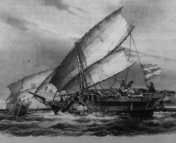Written by Jessie Thwaites, Abby Lee, and Sarah Bodansky
Paper Title: How well-intentioned white male physicists maintain ignorance of inequity and justify inaction
Authors: Melissa Dancy and Apriel Hodari
Corresponding Author Affiliation: Western Michigan University
Status: ArXiv open access
Authors’ note: This Astrobite references racism and sexism in the fields of physics and astronomy, which may be uncomfortable or triggering for some readers.
Disclaimer: “Beyond astro-ph” articles are not necessarily intended to be representative of the views of the entire Astrobites collaboration, nor do they represent the views of the AAS or all astronomers. While AAS supports Astrobites, Astrobites is editorially independent and content that appears on Astrobites is not reviewed or approved by the AAS.
White men are overwhelmingly the dominant group in physics and astronomy. The percentage of non-white or non-male physics faculty is still substantially lower than the general population. And this isn’t even improving substantially – for example, the number of bachelor’s degrees earned by women have hovered between 20-25% for the past 20 years. (For more information about statistics and reports, the American Institute of Physics (AIP) releases statistics and reports on the representation of minoritized identities in physics each year.)
However, in a 2020 survey of STEM professors (described in this paper), 86% of these professors recognized the benefit of increasing diversity efforts (as opposed to 2% who classified these efforts as “detrimental”). With an attitude towards encouraging change, and efforts such as APS Bridge programs or projects to increase diversity, such as the TEAM-UP project, why are people who are non-white and/or non-men still significantly underrepresented?
The authors of this paper aim to address this question, by flipping the script – rather than focusing on those in underrepresented groups, they interview 20 white men and use the lens of critical discourse analysis to focus on the role of those with privilege in maintaining the imbalance seen in the field. Critical discourse analysis is a method that looks not just at the intentional meaning of what the interview subjects say, but also the unconscious impact of the words used and how these ideas reflect the culture around the subjects. All of the interviewees self-identify as progressively minded, and are not intentionally engaging in sexist or racist behavior, but are embedded in a culture which is founded upon white privilege. While their anecdotes and experiences might be different, identifying commonalities in their language reveals underlying themes in their thinking.
This culture, the authors argue, is at least in part maintained through the epistemology of ignorance. This is a type of ignorance that is not due to a lack of knowledge, but rather that people have been taught not to know or encouraged not to undo their ignorance. The culture, founded and sustained through this type of ignorance, has not allowed these white men to recognize and respond to racism or sexism that they witness.
The authors separate their findings into three main themes which stand out from the interviews using the lens of critical discourse analysis.
Theme 1: Physical Distancing
While the interviewees all indicated they believe inequity exists in STEM, they also generally viewed inequity as something that doesn’t happen near them. The interviewees often talked about inequity as if it was happening far away where they had little influence.
More specifically, the participants commonly claimed that inequality was not an issue in their classrooms, research group, department, geographic location, or field. Notably, many of these claims were unbacked by evidence, nor did many of the interviewees report having exerted effort to talk and listen to women or people of color in their department. For example, one senior faculty denied that inequity was present in the courses he taught. After reading about the common experience of social isolation of Black women in STEM courses, he claims he has never encountered something in his own classes. However, he made no mention of receiving feedback from minoritized students to understand their perspective. The interviewees put distance between themselves and sexism or racism in a variety of ways. For example, many claimed that inequity overwhelmingly happens in the South and not their geographic locations, or not in their field (despite physics being one of the least diverse STEM fields), or that their own institution was more liberal and therefore less inequitable. It was also common for both students and faculty to claim they had never witnessed sexism or racism in their research groups or departments, without any evidence.
Not acknowledging sexism or racism as something that happens near them is problematic because it allows these white men to maintain their ignorance. It is necessary for them to engage with women and minorities to better understand the climate before making such claims like “my department has no racism.” By denying that inequity happens anywhere near them, the interviewees maintained ignorance of sexism and racism and therefore positioned themselves as unable to take direct action.
Theme 2: Grand Societal structures
One way in which the interviewees distanced themselves from inequity in physics was by arguing that societal structures of racism and sexism– for example, a leaky pipeline starting in grade school or uneven parenting expectations that disproportionately burden women – prevent change in physics. The participants view these societal structures as too vast and powerful to take action against, and extending beyond the scope of what can be challenged within a physics department.
Several of the younger interviewees believed the power these structures hold within physics can weaken – but not through their own actions. Instead, they argue that the retirement of a generation of old, white, and male physicists will naturally lead to a more diverse and open minded field (ignoring the fact that representation of people of color and women in physics graduate programs remains low). Some participants go so far as to claim that the lack of representation of people of color in physics is due to their assumption that most people of color live in poverty – the authors point out this assumption is rooted in inaccurate stereotypes.
Although the authors acknowledge that societal structures do negatively affect people of color and women in physics, this line of thought disregards that representation is worse in physics relative to other academic fields that would presumably be affected by the same societal issues. By shifting the blame to structures they feel powerless to change, the participants absolve themselves of responsibility in addressing inequity within their own physics departments.
Theme 3: Helplessness
The interviewees justify their inaction when racism or sexism happen near them through a belief that they are helpless to act in some way.
In some cases, participants refused to see the situation presented as sexist or racist, despite obvious evidence to the contrary. One example presented is an interviewee whose research group consists of 40-plus members – only one of them a woman. He expressed surprise upon learning of this extreme gender disparity, despite its obvious existence. Another example given is a situation in which a Black woman in a physics class is isolated by her peers, and several participants assume that this woman is either okay with or wants this isolation, despite her obvious dismay. It is not plausible that these intelligent men do not notice the inequity in these situations – but when they refuse to see, they absolve themselves subconsciously of the need to act.
Another way participants absolve themselves of the need to act was the desire to avoid discomfort – either their own, that of the victim, or even the discomfort of the perpetrator. These men allow their discomfort or desire to be non-confrontational to avoid standing up. Speaking up in the face of racism or sexism can be uncomfortable, but by not doing so those witnessing the incident often appear to side with the perpetrator, or even to condone their behavior.
The participants believe they are not capable of acting – either due to not knowing what to do, believing someone else should step up instead, or believing that the problem is too large for anyone to solve. In reality, people with privilege have the most power to enact change, and the least to lose by speaking up. The attitude that the problem is too large for anyone to solve, that racism and sexism are inevitable, is especially problematic and allows these men to benefit from an oppressive system without challenging it or making themselves uncomfortable along the way.
Recommendations
The authors provide six recommendations as a starting place for people of privilege to begin addressing their own ignorance and the culture of racism and sexism in the field.
The first is to make people of privilege the target of change, rather than those in underrepresented groups in physics. Although initiatives for support are undeniably valuable, targeting people with power and privilege provides an avenue towards the most rapid and influential change. This ties in with another of the recommendations – to make equity work the work of white men. Those with privilege have the most power to enact change, and thus should be viewed as the ones primarily responsible for equity work.
Several recommendations directly address ignorance – both holding people of privilege accountable for their ignorance, and teaching people to recognize the oppression they see. Holding people of privilege accountable for their ignorance in the face of obvious sexism and racism is essential to removing barriers to equity. Paired with this are the recommendations to explicitly teach skills associated with confronting oppression and teach people about common discourse moves that make them complicit in oppression. Many participants felt they lacked the skill or knowledge needed to intervene, and teaching people to how to recognize and respond to patterns of thought and action that support a culture of inequity will help to decrease the use of problematic expressions.
The final recommendation is to collect, and make public, data measuring the extent of inequity in local environments. As is stated by the authors, “ignorance is maintained when perception counts as truth.” Publicizing data on climate and experiences directly addresses this issue.
In a sentence, this article emphasizes how important it is for white men to take an active role in unlearning their own internalized biases, and to work towards an equitable system. White men need to play an essential role in enacting change.
Astrobite edited by: Mark Popinchalk




